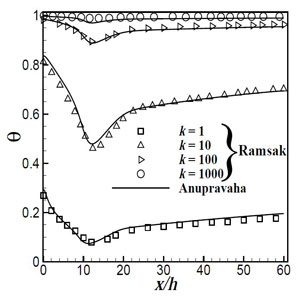MODULES
Conjugate Heat Transfer Of Backward-Facing Step Flow
Problem Definition:
In this problem backward-facing step flow is solved as a conjugate heat transfer, there is some finite thickness of bottom wall and constant temperature is applied at the bottom and upper wall is insulated. The geometry of the problem is shown in Fig. 5.1. In this problem step height is considered to be half of the channel height. Computational domain is divided into 96000 domains, 48000 cells in fluid region and 48000 cells in solid region. Near the walls and near the downstream locations more cells are used. Incompressible and laminar flow is solved combined with energy equation.

Figure 3.1: Sketch of the conjugate forced convection problem of channel

(a) k=1

(b) k=10

(c) k=100

(d) k=1000
Figure 5.2: Effect of k on Isotherms

Figure 5.3: Variation of Temperature along interface
[1] Ramsak M. (2015) ‘Conjugate heat transfer of backward-facing step flow: A benchmark problem revisited’, International Journal of Heat and Mass Trans-fer, vol. 84, pp. 791–799.


